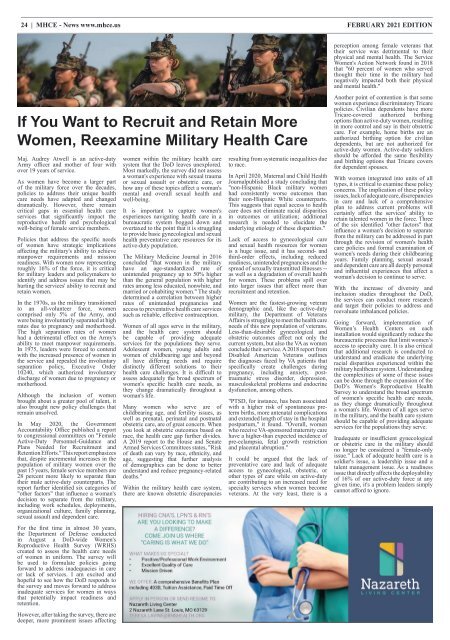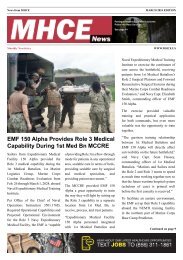Create successful ePaper yourself
Turn your PDF publications into a flip-book with our unique Google optimized e-Paper software.
24 | MHCE - News www.mhce.us FEBRUARY <strong>2021</strong> EDITION<br />
perception among female veterans that<br />
their service was detrimental to their<br />
physical and mental health. The Service<br />
Women's Action Network found in 2018<br />
that "60 percent of women who served<br />
thought their time in the military had<br />
negatively impacted both their physical<br />
and mental health."<br />
If You Want to Recruit and Retain More<br />
Women, Reexamine Military Health Care<br />
Maj. Audrey Atwell is an active-duty<br />
Army officer and mother of four with<br />
over 19 years of service.<br />
As women have become a larger part<br />
of the military force over the decades,<br />
policies to address their unique health<br />
care needs have adapted and changed<br />
dramatically. However, there remain<br />
critical gaps in essential health care<br />
services that significantly impact the<br />
reproductive health and psychological<br />
well-being of female service members.<br />
Policies that address the specific needs<br />
of women have strategic implications<br />
affecting the military's ability to achieve<br />
manpower requirements and mission<br />
readiness. With women now representing<br />
roughly 16% of the force, it is critical<br />
for military leaders and policymakers to<br />
identify and address issues that may be<br />
hurting the services' ability to recruit and<br />
retain women.<br />
In the 1970s, as the military transitioned<br />
to an all-volunteer force, women<br />
comprised only 5% of the Army, and<br />
were being involuntarily separated at high<br />
rates due to pregnancy and motherhood.<br />
The high separation rates of women<br />
had a detrimental effect on the Army's<br />
ability to meet manpower requirements.<br />
In 1975, leaders were forced to contend<br />
with the increased presence of women in<br />
the service and repealed the involuntary<br />
separation policy, Executive Order<br />
10240, which authorized involuntary<br />
discharge of women due to pregnancy or<br />
motherhood.<br />
Although the inclusion of women<br />
brought about a greater pool of talent, it<br />
also brought new policy challenges that<br />
remain unsolved.<br />
In May 2020, the Government<br />
Accountability Office published a report<br />
to congressional committees on "Female<br />
Active-Duty Personnel-Guidance and<br />
Plans Needed for Recruitment and<br />
Retention Efforts." This report emphasizes<br />
that, despite incremental increases in the<br />
population of military women over the<br />
past 15 years, female service members are<br />
28 percent more likely to separate than<br />
their male active-duty counterparts. The<br />
report further identified six categories of<br />
"other factors" that influence a woman's<br />
decision to separate from the military,<br />
including work schedules, deployments,<br />
organizational culture, family planning,<br />
sexual assault and dependent care.<br />
For the first time in almost 30 years,<br />
the Department of Defense conducted<br />
in August a DoD-wide Women's<br />
Reproductive Health Survey (WRHS)<br />
created to assess the health care needs<br />
of women in uniform. The survey will<br />
be used to formulate policies going<br />
forward to address inadequacies in care<br />
or lack of services. I am excited and<br />
hopeful to see how the DoD responds to<br />
the survey and moves forward to address<br />
inadequate services for women in ways<br />
that potentially impact readiness and<br />
retention.<br />
However, after taking the survey, there are<br />
deeper, more prominent issues affecting<br />
women within the military health care<br />
system that the DoD leaves unexplored.<br />
Most markedly, the survey did not assess<br />
a woman's experience with sexual trauma<br />
or sexual assault or obstetric care, or<br />
how any of these topics affect a woman's<br />
mental and overall sexual health and<br />
well-being.<br />
It is important to capture women's<br />
experiences navigating health care in a<br />
bureaucratic system bogged down and<br />
overtaxed to the point that it is struggling<br />
to provide basic gynecological and sexual<br />
health preventative care resources for its<br />
active-duty population.<br />
The Military Medicine Journal in 2016<br />
concluded "that women in the military<br />
have an age-standardized rate of<br />
unintended pregnancy up to 50% higher<br />
than the general population with higher<br />
rates among less educated, nonwhite, and<br />
married or cohabiting women." The study<br />
determined a correlation between higher<br />
rates of unintended pregnancies and<br />
access to preventative health care services<br />
such as reliable, effective contraception.<br />
Women of all ages serve in the military,<br />
and the health care system should<br />
be capable of providing adequate<br />
services for the populations they serve.<br />
Adolescent women, young adults and<br />
women of childbearing age and beyond<br />
all have differing needs and require<br />
distinctly different solutions to their<br />
health care challenges. It is difficult to<br />
assess adequately the broad spectrum of<br />
women's specific health care needs, as<br />
they change dramatically throughout a<br />
woman's life.<br />
Many women who serve are of<br />
childbearing age, and fertility issues, as<br />
well as prenatal, perinatal and postnatal<br />
obstetric care, are of great concern. When<br />
you look at obstetric outcomes based on<br />
race, the health care gap further divides.<br />
A 2019 report to the House and Senate<br />
Armed Services Committees states, "Risk<br />
of death can vary by race, ethnicity, and<br />
age, suggesting that further analysis<br />
of demographics can be done to better<br />
understand and reduce pregnancy-related<br />
deaths."<br />
Within the military health care system,<br />
there are known obstetric discrepancies<br />
resulting from systematic inequalities due<br />
to race.<br />
In April 2020, Maternal and Child Health<br />
Journalpublished a study concluding that<br />
"non-Hispanic Black military women<br />
had consistently worse outcomes than<br />
their non-Hispanic White counterparts.<br />
This suggests that equal access to health<br />
care does not eliminate racial disparities<br />
in outcomes or utilization; additional<br />
research is needed to elucidate the<br />
underlying etiology of these disparities."<br />
Lack of access to gynecological care<br />
and sexual health resources for women<br />
is a huge issue, and it has second- and<br />
third-order effects, including reduced<br />
readiness, unintended pregnancies and the<br />
spread of sexually transmitted illnesses --<br />
as well as a degradation of overall health<br />
for women. These problems spill over<br />
into larger issues that affect more than<br />
recruitment and retention.<br />
Women are the fastest-growing veteran<br />
demographic and, like the active-duty<br />
military, the Department of Veterans<br />
Affairs is struggling to meet the health care<br />
needs of this new population of veterans.<br />
Less-than-desirable gynecological and<br />
obstetric outcomes affect not only the<br />
current system, but also the VA as women<br />
conclude their service. A 2018 report from<br />
Disabled American Veterans outlines<br />
the diagnoses faced by VA patients that<br />
specifically create challenges during<br />
pregnancy, including anxiety, posttraumatic<br />
stress disorder, depression,<br />
musculoskeletal problems and endocrine<br />
dysfunction, among others.<br />
"PTSD, for instance, has been associated<br />
with a higher risk of spontaneous preterm<br />
births, more antenatal complications<br />
and extended length of stay in the hospital<br />
postpartum," it found. "Overall, women<br />
who receive VA-sponsored maternity care<br />
have a higher-than expected incidence of<br />
pre-eclampsia, fetal growth restriction<br />
and placental abruption."<br />
It could be argued that the lack of<br />
preventative care and lack of adequate<br />
access to gynecological, obstetric, or<br />
other types of care while on active-duty<br />
are contributing to an increased need for<br />
specialty services when women become<br />
veterans. At the very least, there is a<br />
Another point of contention is that some<br />
women experience discriminatory Tricare<br />
policies. Civilian dependents have more<br />
Tricare-covered authorized birthing<br />
options than active-duty women, resulting<br />
in more control and say in their obstetric<br />
care. For example, home births are an<br />
authorized birthing option for civilian<br />
dependents, but are not authorized for<br />
active-duty women. Active-duty soldiers<br />
should be afforded the same flexibility<br />
and birthing options that Tricare covers<br />
for dependent spouses.<br />
With women integrated into units of all<br />
types, it is critical to examine these policy<br />
concerns. The implication of these policy<br />
issues, lack of adequate care, discrepancies<br />
in care and lack of a comprehensive<br />
plan to address current problems will<br />
certainly affect the services' ability to<br />
retain talented women in the force. Three<br />
of the six identified "other factors" that<br />
influence a woman's decision to separate<br />
from the military can be addressed in part<br />
through the revision of women's health<br />
care policies and formal examination of<br />
women's needs during their childbearing<br />
years. Family planning, sexual assault<br />
and dependent care are all deeply personal<br />
and influential experiences that affect a<br />
woman's decision to continue to serve.<br />
With the increase of diversity and<br />
inclusion studies throughout the DoD,<br />
the services can conduct more research<br />
and target their policies to address and<br />
reevaluate imbalanced policies.<br />
Going forward, implementation of<br />
Women’s Health Centers on each<br />
installation would significantly reduce the<br />
bureaucratic processes that limit women’s<br />
access to specialty care. It is also critical<br />
that additional research is conducted to<br />
understand and eradicate the underlying<br />
racial disparities experienced within the<br />
military healthcare system. Understanding<br />
the complexities of some of these issues<br />
can be done through the expansion of the<br />
DoD’s Women's Reproductive Health<br />
Survey to understand the broad spectrum<br />
of women's specific health care needs,<br />
as they change dramatically throughout<br />
a woman's life. Women of all ages serve<br />
in the military, and the health care system<br />
should be capable of providing adequate<br />
services for the populations they serve.<br />
Inadequate or insufficient gynecological<br />
or obstetric care in the military should<br />
no longer be considered a "female-only<br />
issue." Lack of adequate health care is a<br />
soldier's issue, a leadership issue and a<br />
talent management issue. As a readiness<br />
issue that directly affects the deployability<br />
of 16% of our active-duty force at any<br />
given time, it's a problem leaders simply<br />
cannot afford to ignore.


















